PONTIAC PONTIAC 1995 Owners Manual
Manufacturer: PONTIAC, Model Year: 1995, Model line: PONTIAC, Model: PONTIAC PONTIAC 1995Pages: 354, PDF Size: 17.27 MB
Page 211 of 354
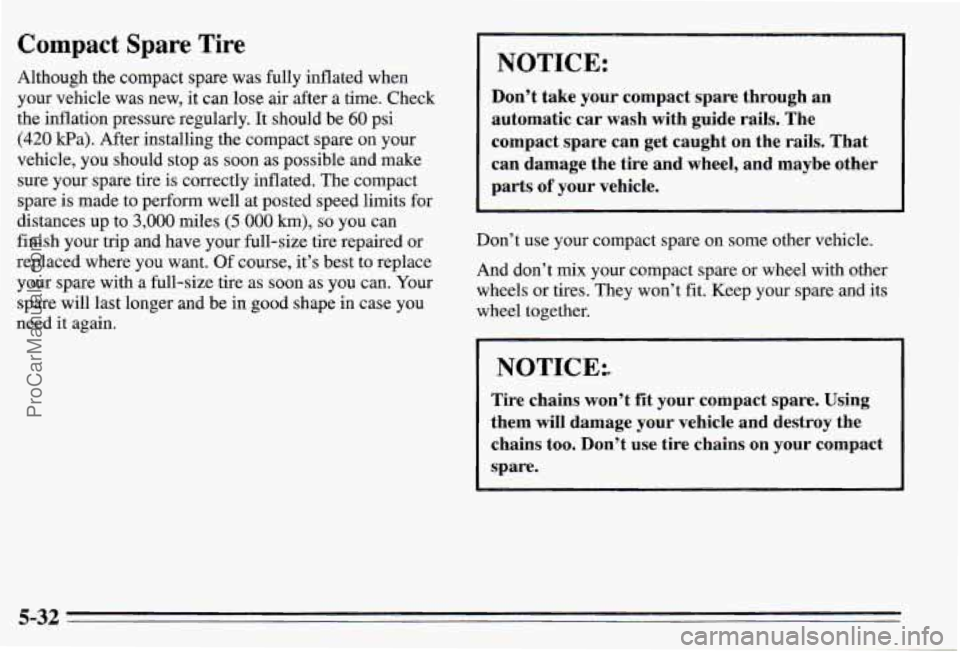
Compact Spare Tire
Although the compact spare was fully inflated when
your vehicle was new, it can lose air after a time. Check
the inflation pressure regularly. It should be
60 psi
(420 kPa). After installing the compact spare on your
vehicle,
you should stop as soon as possible and make
sure your spare tire is correctly inflated. The compact
spare is made to perform well at posted speed limits for
distances up to
3,000 miles (5-000 km), so you can
finish your trip and have your full-size tire repaired
or
replaced where you want. Of course, it’s best to replace
your spare with a full-size tire as soon as you can.
Your
spare will last longer and be in good shape in case you
need it again.
NOTICE:
Don’t take your compact spare through an
automatic car wash with guide rails. The
compact spare can get caught on the rails. That
can damage the tire and wheel, and maybe other
parts
of your vehicle.
Don’t use your compact spare on some other vehicle.
And don’t mix your compact spare
or wh.ee1 with other
wheels or tires. They won’t fit. Keep your spare and its
wheel together.
NOTICE:
Tire chains won’t fit your compact spare. Using
them will damage your vehicle and destroy the
chains too. Don’t use tire chains on your compact
spare.
5-32
ProCarManuals.com
Page 212 of 354
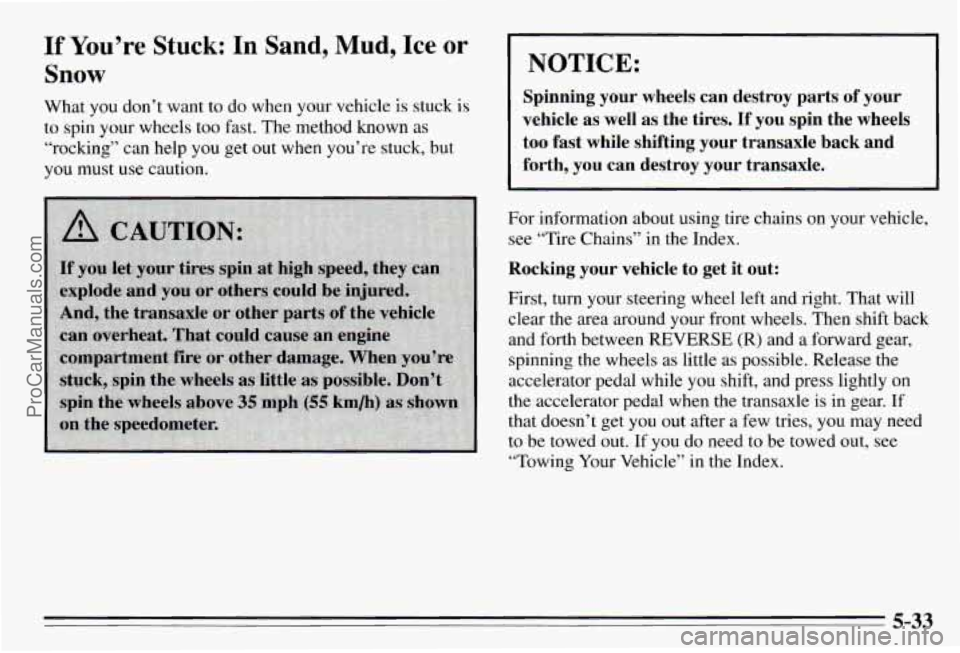
If You’re Stuck: In Sand, Mud, Ice or
Snow NOTICE:
What you don’t want to do when your vehicle is stuck is
to spin your wheels too fast. The method known
as
“rocking” can help you get out when you’re stuck, but
you must use caution.
Spinning your wheels can destroy parts of your
vehicle
as well as the tires. If you spin the wheels
too fast while shifting your transaxle back and
forth, you can destroy your transaxle.
For information about using tire chains on your vehicle.
see “Tire Chains” in the Index.
Rocking your vehicle to get it out:
First, turn your steering wheel left and right. That will
clear the area around your front wheels. Then shift back
and forth between REVERSE (R) and a forward gear,
spinning the wheels as 1.ittle as possible. Release the
accelerator pedal while you shift, and press lightly
on
the accelerator pedal when the transaxle is in gear. If
that doesn’t get you out after a few tries, you may need
to be towed out. If you do need to be towed out, see
“Towing Your Vehicle” in the Index.
5-33
ProCarManuals.com
Page 213 of 354
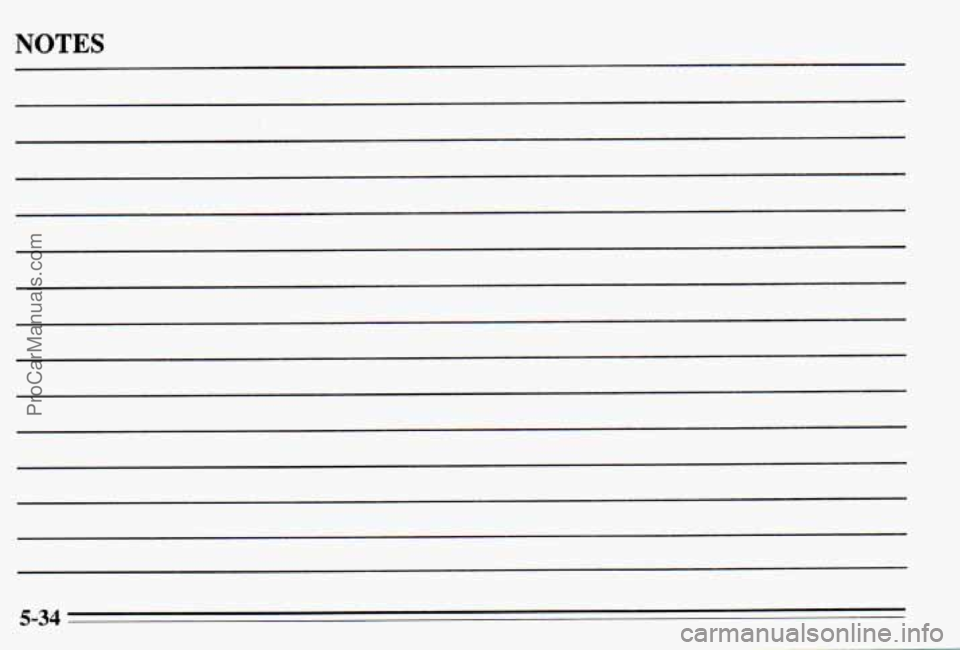
NOTES
5-34
ProCarManuals.com
Page 214 of 354
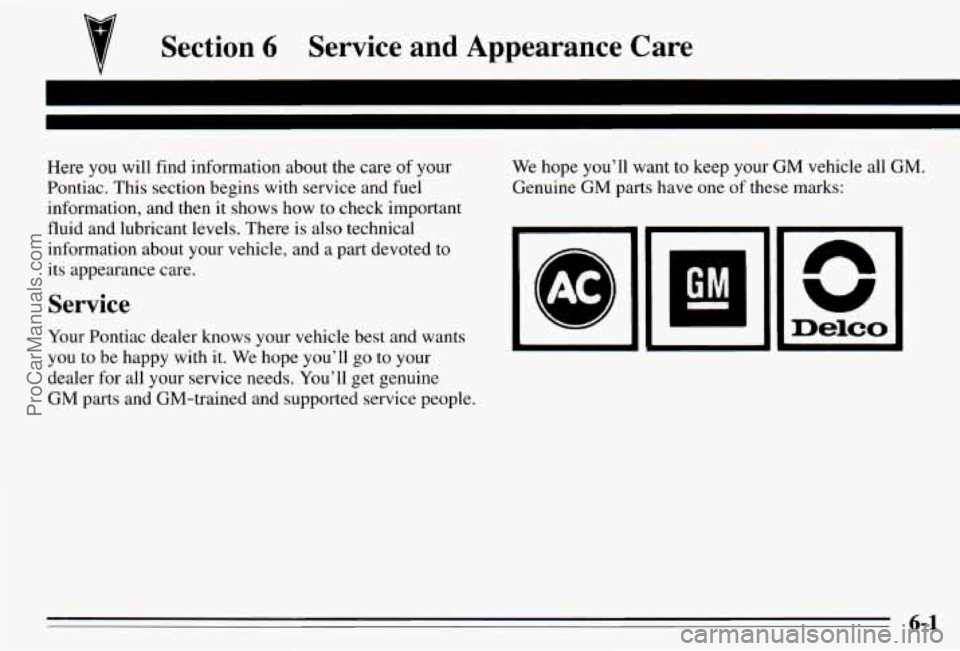
Section 6 Service and Appearance Care
Here you will find information about the care of your We hope you’ll want to keep your GM vehicle all GM.
Pontiac. This section begins with service and fuel Genuine GM parts have one of these marks:
information, and then it shows how
to check important
fluid and lubricant levels. There is also technical
information about your vehicle, and a part devoted to
its appearance care.
Service
Your Pontiac dealer knows your vehicle best and wants
you
to be happy with it. We hope you’ll go to your
dealer
for all your service nee& You’ll get genuine
GM parts and GM-trained and supported service people.
6-1
ProCarManuals.com
Page 215 of 354
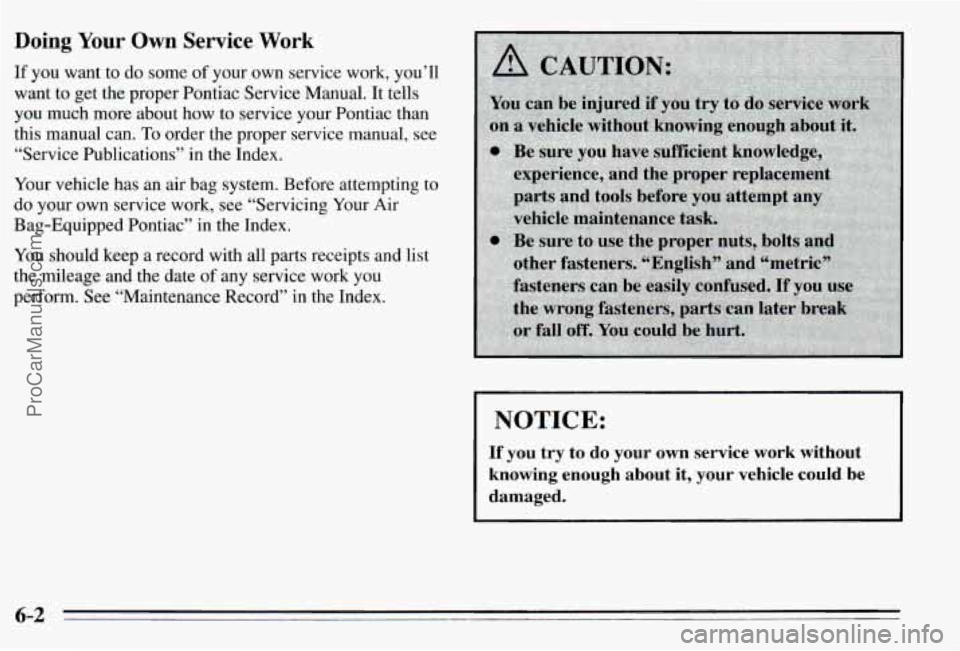
Doing Your Own Service Work
If you want to do some of your own service work, you’ll
want to get the proper Pontiac Service Manual. It tells
you much more about how to service your Pontiac than
this manual can. To order the proper service manual, see
“Service Publications” in the Index.
Your vehicle
has an air bag system. Before attempting to
do your own service work, see “Servicing Your Air
Bag-Equipped Pontiac” in the Index.
You should keep a record with all
parts receipts and list
the mileage and the date
of any service work you
perform. See “Maintenance Record”
in the Index.
I NOTICE:
If you try to do your own service work without
knowing enough about it, your vehicle could be
damaged.
6-2
ProCarManuals.com
Page 216 of 354
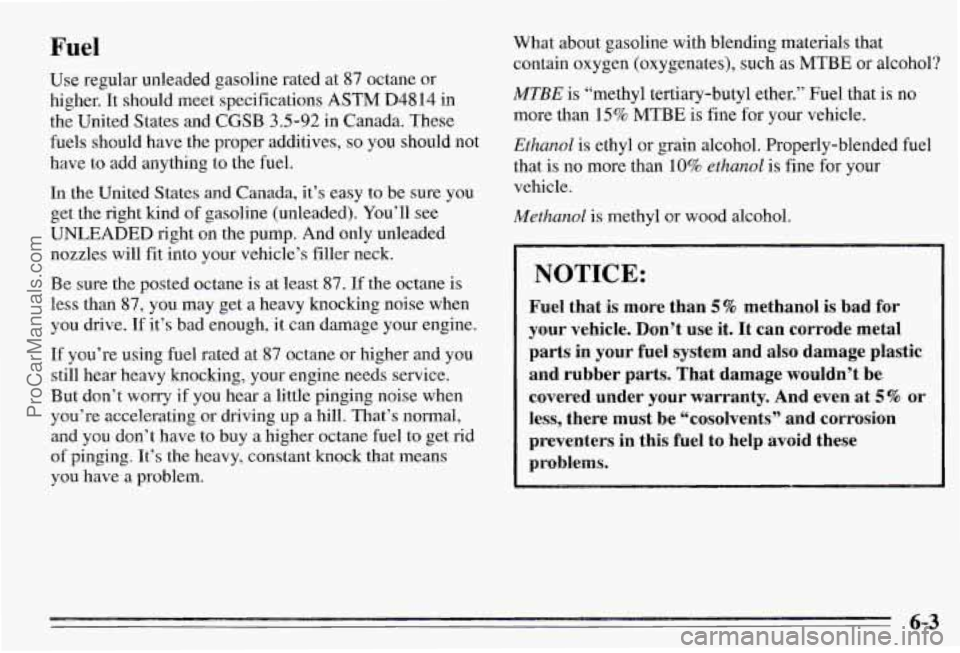
Fuel
Use regular unleaded gasoline rated at 87 octane or
higher.
It should meet specifications ASTM D4814 i.n
the United States and CGSB 3592 in Canada. These
hels should have the proper additives,
so you should not
have to add anything to the fuel.
h the United States and Canada, it’s easy to be sure you
get the right kind
of gasoline (unlea.ded). You.’ll see
UNLEADED right on the pump. And only unleaded
nozzles will fit into your vehicle’s filler neck.
Be sure the posted octane is
at least 87. If the octane is
less than
87, you may get a heavy knocking noise when
you drive. If it’s bad enough,
it can damage your engine.
Lf you’re using fuel rated at 87 octane or higher and you
still hear heavy hocking, your engine needs service.
But don’t
worry if you hear a little pinging noise when
you’re accelerating or driving up a hill. That’s normal,
and you dan’t have to buy a higher octane fuel to get rid
of pinmg. It’s the heavy, constant knock that means
you have a problem. What
about gasoline with blending materials that
contain oxygen (oxygenates), such
as MTBE or alcohol?
MTBE is “methyl tertiary-butyl ether.” Fuel that is no
more than
15% MTBE is fine for your vehicle.
Ethanol is ethyl or grain alcohol. Properly-blended fuel
that is no more than
10% ethanol is fine for your
vehicle.
Methanol is methyl or wood alcohol.
Fuel that is more than 5% methanol is bad for
your vehicle. Don’t use it. It can corrode metal parts
in your fuel system and also damage plastic
and rubber parts, That damage wouldn’t
be
covered under your warranty. And even at 5 % or
less, there must be “cosolvents’’ and corrosion
preventers
in this fuel to help avoid these
6-3
ProCarManuals.com
Page 217 of 354
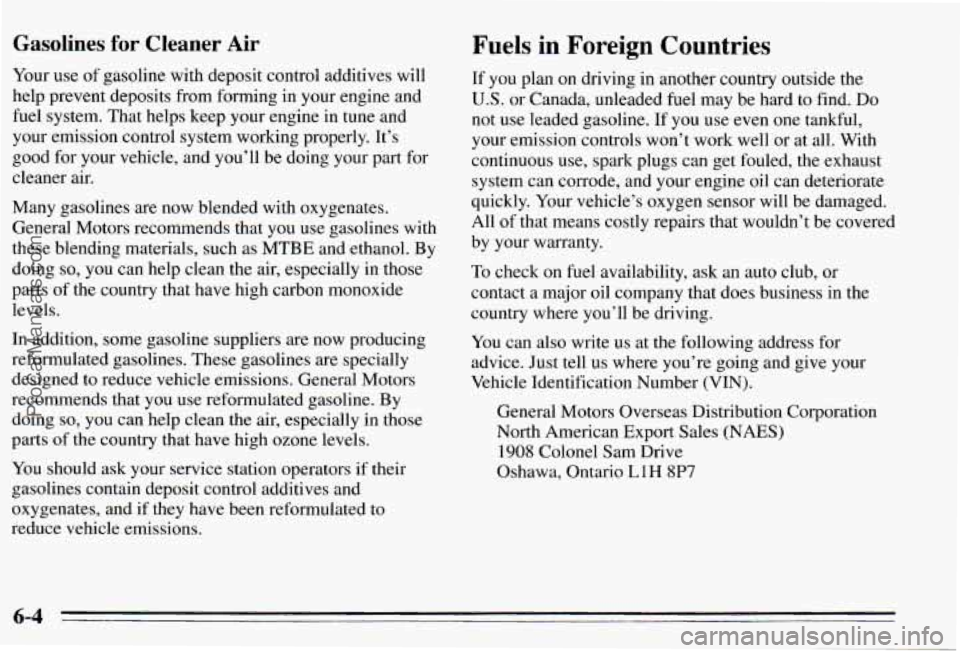
Gasolines for Cleaner Air Fuels in Foreign Countries
Your use of gasoline with deposit control additives will
help prevent deposits from forming in your engine and
fuel system. That helps keep your engine in tune and
your emission control system working properly. It’s
good for your vehicle, and you’ll be doing your part for
cleaner air.
Many gasolines are now blended with oxygenates. General Motors recommends that you use gasolines with
these blending materials, such as MTBE and ethanol. By
doing
so, you can help clean the air, especially in those
parts of the country that have high carbon monoxide
levels.
In addition, some gasoline suppliers
are now producing
reformulated gasolines. These gasolines
are specially
designed to reduce vehicle emissions. General Motors
recommends that you use reformulated gasoline. By
doing
so, you can help clean the air, especially in those
parts
of the country that have high ozone levels.
You should ask your service station operators if their
gasolines contain deposit control additives and
oxygenates, and if they have been reformulated to
reduce vehicle emissions.
If you plan on driving in another country outside the
U.S. or Canada, unleaded fuel may be hard to find. Do
not use leaded gasoline. If you use even one tankful,
your emission controls won’t work well or at all. With
continuous use, spark plugs can get fouled, the exhaust system can corrode, and
your engine oil can deteriorate
quickly. Your vehicle’s oxygen sensor will be damaged.
All of that means costly repairs that wouldn’t be covered
by your warranty.
To check on fuel availability, ask an auto club, or
contact a major oil company that does business in the
country where you’ll be driving.
You can also write us at the following address for
advice. Just tell
us where you’re going and give your
Vehicle Identification Number
(VIN).
General Motors Overseas Distribution Corporation
North American Export Sales (NAES)
1908 Colonel Sam Drive
Oskawa, Ontario
L1H 8P7
6-4
ProCarManuals.com
Page 218 of 354
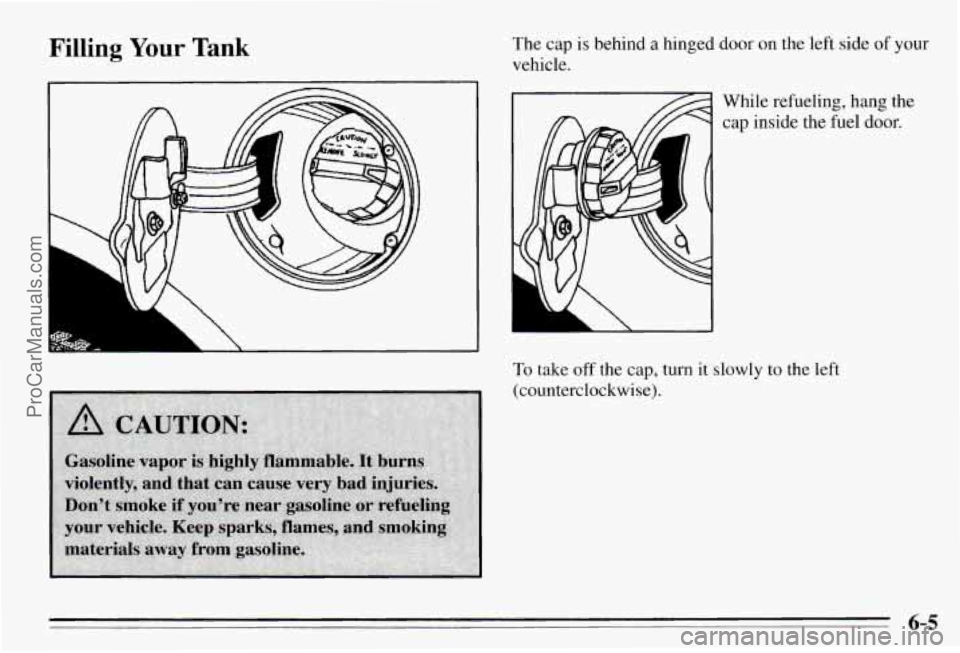
Filling Your Tank The cap is behind a hinged door on the left side of your
vehicle.
While refueling, hang the cap inside the fuel
door.
To take off the cap, turn it slowly to the left
(counterclockwise).
6-5
ProCarManuals.com
Page 219 of 354
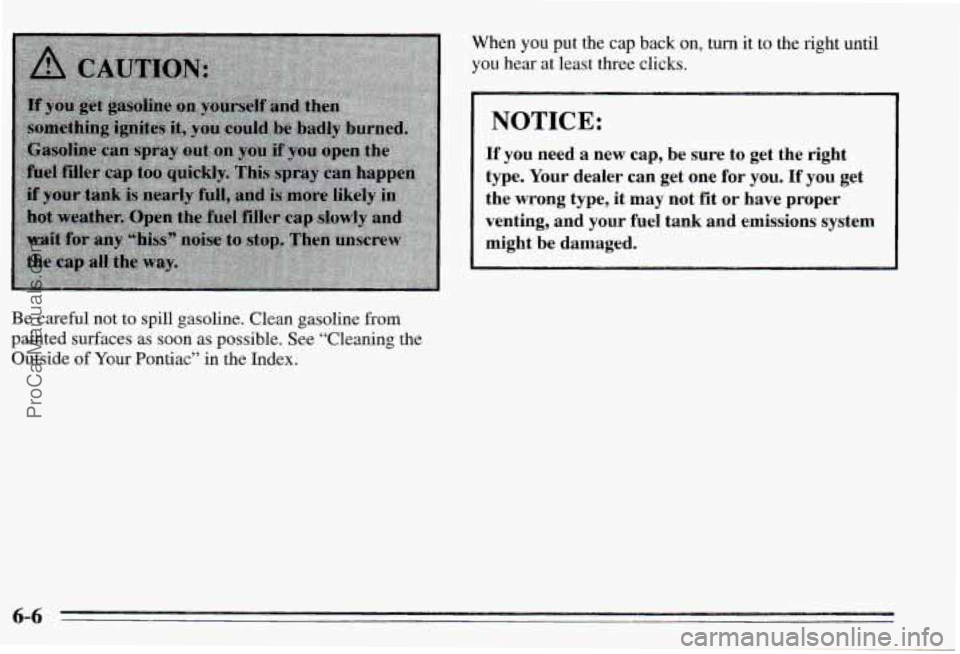
Be careful not to spill gasoline. Clean gasoline from
painted surfaces as soon as possible. See “Cleaning the
Outside
of Your Pontiac” in the Index. When
you put the cap back on, turn it to the right until
you hear at least three
clicks.
I NOTICE:
If you need a new cap, be sure to get the right
type. Your dealer can get
one for you. If you get
the wrong type, it may not fit
or have proper
venting, and your fuel tank and emissions system
might be damaged.
6-6
ProCarManuals.com
Page 220 of 354
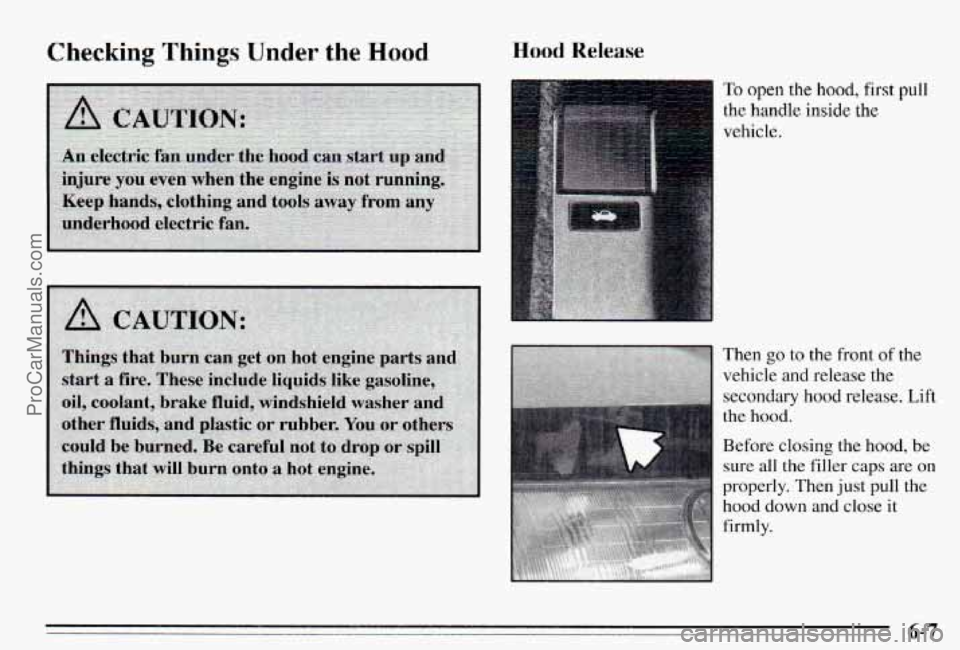
Checking Things Under the Hood Hood Release
To open the hood, first pull
the handle inside the
vehicle.
Then
go to the front of the
vehicle and release
the
secondary hood release. Lift
the hood.
Before closing the hood,
be
sure all the filler caps are on
properly. Then just pull the
hood down and close it
firmly.
6-7 ProCarManuals.com